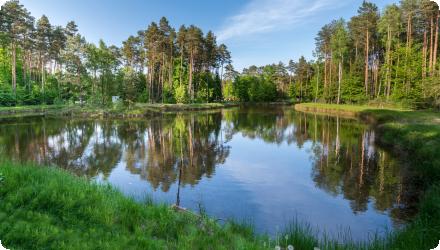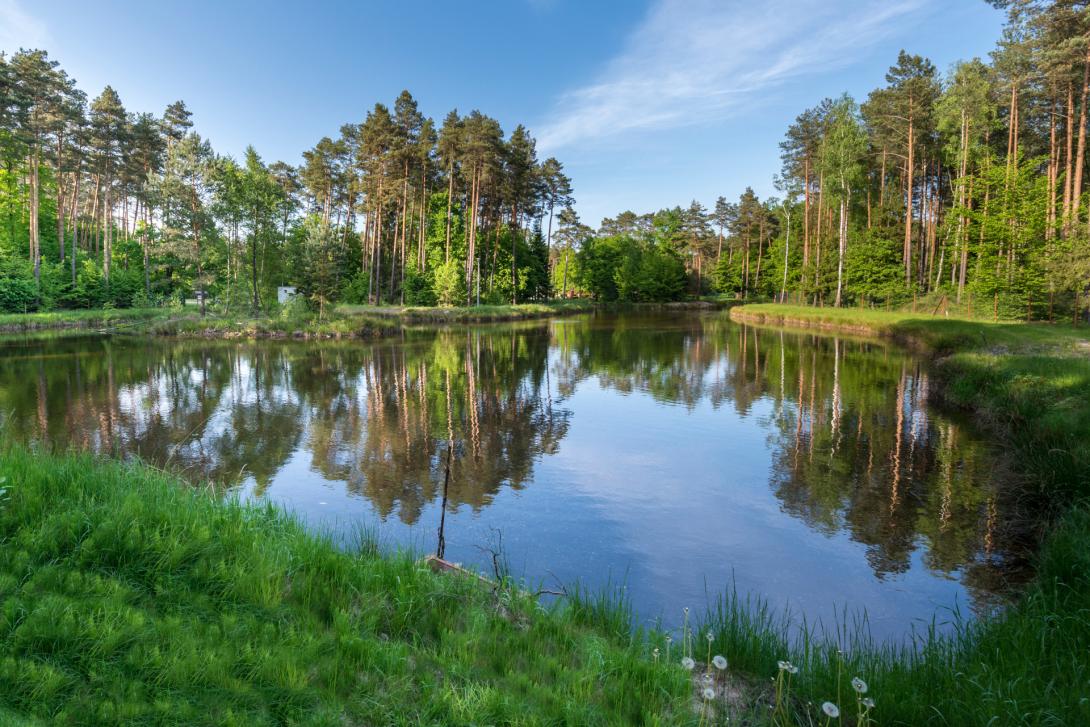Last update
2025
Summary
Forest ecosystems in Poland have long suffered from drought and rapid surface water runoff. Since the mid-1990s, the Polish State Forests (Lasy Państwowe) have implemented small-scale water retention measures, supported by internal and external funding (e.g. the Polish Ecofund and the National Fund for Environmental Protection and Water Management). In 2006, these initiatives were consolidated into a nationwide programme entitled "Increasing retention and preventing floods and droughts in forest ecosystems in lowlands", supported by the EU Cohesion Fund (2007–2013).
It was the first programme of this scale to combine forest-based retention with flood and drought mitigation. Over time, thousands of small hydraulic structures (ponds, weirs, ditches, culverts) were installed, enhancing water retention and reducing peak flows. For instance, in the Świętokrzyskie region, 43 reservoirs and 61 small barriers retain over 1 million m³ of water.
The programme has continued under successive phases and remains a key component of Poland’s climate adaptation strategy. As of 2023–2025, additional funding (including EU funds) supports the development of lowland and mountain retention systems, with proven benefits: higher groundwater levels, improved soil moisture, and enhanced biodiversity. The approach focuses on restoring natural hydrology without disrupting forest functions.
Institutional coordination has improved, with national guidelines, monitoring tools, and good practices shared via the State Forests Centre for Coordination of Environmental Projects (CKPŚ). The programme is now considered a model of nature-based climate resilience in forestry.
It was the first programme of this scale to combine forest-based retention with flood and drought mitigation. Over time, thousands of small hydraulic structures (ponds, weirs, ditches, culverts) were installed, enhancing water retention and reducing peak flows. For instance, in the Świętokrzyskie region, 43 reservoirs and 61 small barriers retain over 1 million m³ of water.
The programme has continued under successive phases and remains a key component of Poland’s climate adaptation strategy. As of 2023–2025, additional funding (including EU funds) supports the development of lowland and mountain retention systems, with proven benefits: higher groundwater levels, improved soil moisture, and enhanced biodiversity. The approach focuses on restoring natural hydrology without disrupting forest functions.
Institutional coordination has improved, with national guidelines, monitoring tools, and good practices shared via the State Forests Centre for Coordination of Environmental Projects (CKPŚ). The programme is now considered a model of nature-based climate resilience in forestry.
Position
Latitude
52.2316
Longitude
21.0065
Project
NWRM
National Id
Poland_02
Installation date
2014
Transboundary
0
Photo gallery
Location of the project
Nationwide across lowland forests in Poland, with documented implementation in forest districts of Świętokrzyskie Voivodeship (e.g. under the Radom Directorate of State Forests), and in other voivodeships such as Mazowsze, Podlaskie, and Lubelskie.
Project's objectives
1. Increase water retention capacity in forest ecosystems : by 31.4 million m³ in lowland forests through the construction of ~3,180 small retention structures.
2. Reduce the risk of floods and droughts
3. Restore natural hydrological functions of forest landscapes
4. Support biodiversity and improve habitat conditions
5. Integrate water retention into sustainable forest management
2. Reduce the risk of floods and droughts
3. Restore natural hydrological functions of forest landscapes
4. Support biodiversity and improve habitat conditions
5. Integrate water retention into sustainable forest management
Involved Partners
| Authority type | Authority name | Role | Comments |
|---|---|---|---|
Climate zone
cool temperate dry
Temperature
7 °C
Annual rainfall range
300 - 600 mm
Water bodies: Ecological Status
Depends on the site
Water bodies: Chemical Status
Depends on the site
Project scale
Large
Project scale specification
The Small Water Retention Program in Forests (lowlands) of Poland is a macro-scale initiative. It was implemented nationwide, across multiple voivodeships and forest districts, under the coordination of Lasy Państwowe (State Forests) and national ministries. The programme spans various lowland catchments and aims to address national-scale issues such as drought, flooding, and climate resilience in forest ecosystems. It involved thousands of small retention structures and has been integrated into Poland’s broader climate adaptation and water management policies, making it clearly aligned with the definition of a macro-scale intervention.
Performance timescale
> 20 years
Project area
1e+06
Total cost
€ 50,000,000
Costs total information
Without the mountain retention program : around €39 million
Financing authorities
Type of funding
Local funds
Comments
Significant contribution from internal budgets of Lasy Państwowe for planning, execution, and maintenance.
Compensations
0
Policy context
The seasonal climate variation including higher spring precipitation and summer dry periods combined with a long lasting drainage have led to excessive drought occurring in forest ecosystems. In response to water management needs, the State Forests since the mid-90’s have been undertaking small scale water retention works. Small scale retention actions have been financed from own and external funds (i.e. Ecofund, National Fund for Environmental Protection and Water Management).
Land ownership
The land is publicly owned by the State Treasury and managed by Lasy Państwowe (State Forests).
Community involvment
No
Design consultation activity
| Activity stage | Name | Key issues | Comments |
|---|
Policy target
| Target purpose |
|---|
|
Increase Water Storage
|
|
Groundwater Recharge
|
|
Runoff control
|
Policy pressure
| Pressure directive | Relevant pressure |
|---|
Policy impact
| Impact directive | Relevant impact |
|---|
Requirement directive
| Requirement directive | Specification |
|---|
Contractual arrangements
1
| Arrangement type | Responsibility | Role | Name | Comments |
|---|---|---|---|---|
|
Institutional arrangement
|
Agreement between between the Ministry of Agriculture and Food Economy and the Minister of Environmental Protection, Natural Resources and Forestry of Poland on cooperation in the field of the development of small water retention
|
Part of wider plan
1
Wider plan type
| Wider plan type | Wider plan focus | Name | Comments |
|---|
Monitoring is coordinated at the national level by the State Forests’ Centre for Coordination of Environmental Projects (CKPŚ), using internal databases and technical guidelines to assess the condition and hydrological performance of the structures.
Monitoring focuses on both technical and hydrological parameters. These include the structural condition of retention installations (e.g. stability, blockage, erosion signs), the volume of retained water, and groundwater levels in adjacent areas. In some cases, biodiversity indicators such as wetland flora/fauna presence are also tracked. Forest districts conduct field assessments based on standardized national manuals and report data to central coordination units. During the 2007–2015 operational period, monitoring was linked to EU Cohesion Fund requirements, with data stored in structured project databases to evaluate effectiveness, support reporting, and plan maintenance operations.
Maintenance
Maintenance of the small retention structures is carried out by local forest districts (Lasy Państwowe), who are responsible for regular inspections, cleaning, and upkeep of weirs, culverts, ditches, and reservoirs to ensure proper functionality.
Improved Access to Green Areas & Recreation.
Local Economic Functions at Community Level : Small water power (micro-hydro), Fish breeding, Water supply for agriculture and forestry, Recreational uses.
Broad Ecosystem-Based Socio-Economic Value : The Biodiversity Information System notes that combining forest retention with flood prevention provides a model of environmentally friendly infrastructure that supports biodiversity protection and has significant socio‑economic influence, reinforcing benefits beyond strictly hydrological functions.
Local Economic Functions at Community Level : Small water power (micro-hydro), Fish breeding, Water supply for agriculture and forestry, Recreational uses.
Broad Ecosystem-Based Socio-Economic Value : The Biodiversity Information System notes that combining forest retention with flood prevention provides a model of environmentally friendly infrastructure that supports biodiversity protection and has significant socio‑economic influence, reinforcing benefits beyond strictly hydrological functions.
Information on retained water
The programme created 43 new reservoirs and constructed 61 dams or water-damming devices, retaining over 1 million m³ of water
Information on Increased groundwater level
Preliminary observations showed increased groundwater levels in areas surrounding the retention structures
Information on Soil moisture
The increased groundwater elevated soil moisture in adjoining forest habitats
Increased landscape storage capacity
27
Increased landscape storage capacity unit
%
Information on Increased landscape storage capacity
increased water storage from the present 8 380 253 m3 (2007) to approx. 31 million m3 (in 2014)
1
There was a noted increase in biodiversity, greater accumulation of dead wood, and improved soil conditions near retention sites.
Providing habitat for typical wetland flora species: Iris sibirica; Cypripedium calceolus; Eriphorum vaginatum; Oxycoccus palustris; Nymphaea alba; Nymphaea candida
providing habitat for typical wetland fauna species: Hyla arborea; Emys orbicularis; Salamandra salamandra; Castor fiber; Lyrurus tetrix
Providing habitat for typical wetland flora species: Iris sibirica; Cypripedium calceolus; Eriphorum vaginatum; Oxycoccus palustris; Nymphaea alba; Nymphaea candida
providing habitat for typical wetland fauna species: Hyla arborea; Emys orbicularis; Salamandra salamandra; Castor fiber; Lyrurus tetrix
Key lessons
Small-scale measures can deliver large-scale impact : Although the program relied on numerous small structures (ponds, weirs, culverts), their cumulative effect significantly improved water retention, groundwater levels, and ecosystem resilience across large forested areas. This demonstrates the effectiveness of decentralized nature-based solutions when implemented at scale.
Long-term national coordination is essential : The success of the program depended on a centralised coordination mechanism (via CKPŚ within Lasy Państwowe) and integration into national strategies and EU programmes. This long-term governance model ensured continuity across funding cycles and administrative changes.
Multifunctionality increases value : The project illustrates how forest infrastructure can be designed to serve multiple functions: hydrological regulation, biodiversity support, recreation, local livelihoods (fish farming, micro-hydro). This multifunctional approach strengthens public and institutional support.
Monitoring and adaptive management are needed : While basic monitoring was implemented (e.g. structure condition, groundwater), limited data on water quality, biodiversity trends, or long-term climate impacts suggests a need for stronger environmental monitoring to guide adaptive management.
Public forest ownership enabled rapid implementation : Because the land was publicly owned and managed, the program avoided complex land acquisition or permitting procedures, enabling efficient and large-scale implementation. This highlights the strategic value of public land in green infrastructure projects.
Long-term national coordination is essential : The success of the program depended on a centralised coordination mechanism (via CKPŚ within Lasy Państwowe) and integration into national strategies and EU programmes. This long-term governance model ensured continuity across funding cycles and administrative changes.
Multifunctionality increases value : The project illustrates how forest infrastructure can be designed to serve multiple functions: hydrological regulation, biodiversity support, recreation, local livelihoods (fish farming, micro-hydro). This multifunctional approach strengthens public and institutional support.
Monitoring and adaptive management are needed : While basic monitoring was implemented (e.g. structure condition, groundwater), limited data on water quality, biodiversity trends, or long-term climate impacts suggests a need for stronger environmental monitoring to guide adaptive management.
Public forest ownership enabled rapid implementation : Because the land was publicly owned and managed, the program avoided complex land acquisition or permitting procedures, enabling efficient and large-scale implementation. This highlights the strategic value of public land in green infrastructure projects.
Success factor(s)
| Success factor type | Success factor role | Comments | Order |
|---|---|---|---|
|
Other
|
main factor
|
Public ownership of land – Simplified implementation on State-managed forest lands without land acquisition issues. |
|
|
Attitude of relevant stakeholders
|
secondary factor
|
Strong institutional coordination – Led by Lasy Państwowe and CKPŚ, ensuring consistency across regions. |
|
|
Financing possibilities
|
main factor
|
EU and national co-financing – Stable funding from the Cohesion Fund, EcoFund, and national environmental budgets. |
|
|
Existing staff and consultant knowledge
|
secondary factor
|
Local implementation capacity – Forest districts had technical expertise and staff for design, maintenance, and monitoring. |
Driver
| Driver type | Driver role | Comments | Order |
|---|---|---|---|
|
Balancing different objectives
|
main driver
|
necesity to improve water amangement in forest lowlands
|
1
|
|
Availability of subsidies
|
main driver
|
Cohesion Fund in frames of Operational Programme, 2007-2014
|
2
|
Transferability
This measure is highly transferable to other regions with publicly managed forest land and seasonal water imbalance.
English

